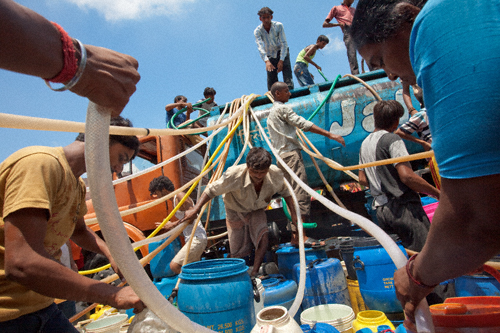The Annenberg Space for Photography lends itself well to documentary-like exhibitions. The Space has a reverence for the technology that goes into taking photographs and displaying them - as soon as you walk inside, you recognize that its not just four white walls that accommodate just any artist's work. You're met with curved walls, futuristic interactive photographic display tables, and a round screening room at the center allowing you to experience photographs in a more intimate way. The Space itself absolutely heightens the way you encounter the work on view.
Celebrating The Space's one-year-anniversary is an unprecedented exhibit that sees the Annenberg Foundation teaming up with National Geographic Magazine to showcase the work of six photographers featured in the magazine's April issue focusing on water. Water: Our Thirsty World, on view now through June 13, 2010, reveals the realities of water, the problems around it, sacredness of it, and inequalities it creates.
The exhibit couldn't be a better fit for the Space both physically and with regard to the Annenberg's devotion to philanthropy. From offering free admission to curating exhibits with a human or social message, The Space for Photography goes beyond displaying the work of some popular, emerging artist. Their exhibits aspire to reveal what photography can accomplish - it's a tangible recognition of the fact that photography can pull back the veil on educational, political, and social issues just as it can expose and commemorate cultural truths for generations to come.
Water: Our Thirsty World is as harrowing as it sounds. But (and that's a big but) it's not depressing in that it becomes overwhelming and thus off-putting. The beauty and fervor with which people celebrate water in countries like Japan, India, and Haiti contrasts photos documenting the starkness of the thirsty and desperate areas of Kenya and Tibet. Some images show places flooded with too much water, dirty water. In some areas, thirsty people with chapped skin try to decontaminate murky water they fight to acquire from a well nearby. That these regions are often not very far apart is enough to make us all stomp our feet like 7-year-olds saying "its so unfair!" That's the accomplishment of this exhibit - that it makes you feel impassioned and moved with just one walk-through.

Each section of the magazine's water issue has its own space in the exhibit - the "Sacred Waters" segment, photographed by John Stanmeyer, chronicles the ceremonies that cultures and religions harbor around the world in celebration of water while photographer Lynn Johnson's "The Burden of Thirst" looks at the physical, emotional, and economical burden of trying to get access to water in Kenya, Ethiopia, and Tanzania.
One segment that hits particularly close to home is photographer Edward Burtynsky's "California's Pipe Dream." Only through his photos can you begin to realize the kind of trouble this state is really in - put down the Voss and look at the trickle of water that is the Los Angeles River. According to Burtynsky's photos, this region, a natural desert, is working its way back to its original state. Our pipes and dams are no longer able to sustain our cities, industries, and personal needs.
In photographer Paolo Pellegrin's section "Parting the Waters," we're met with a blunt look at the politics of water, specifically in the Middle East. The situation there serves as representative of the wars and power struggles that derive from water and the lack thereof. Geography plays an obvious role in the situation between Israel, Jordan, and Syria - Israel has blocked Syria's access to the plentiful Sea of Galilee since 1967.
The exhibit is so successful because unlike public-service-announcements and snaps from celebrities' trips to battered nations, these photographs are pulled from the pages of National Geographic Magazine. It's the photographer's story that's on display. Once given their assignment, these intrepid photographers went to live in far-flung locales searching for a story that would uncover the truth; the photos weren't taken with an exhibit in mind. One could even say that considering these were photographic journalism assignments, the exhibit feels validated, believable, and worth paying attention to. These weren't taken by hippies who've traded the boardroom for Birkenstocks; they were taken by professional photographers whose mission was to reveal a problem that stems from our very core. They became impassioned along the way, which is precisely the effect the exhibit has on its viewers.
As part of the full Annenberg experience, many featured photographers and other National Geographic team members will speak in lectures and workshops bringing you closer still into the inner workings of this exhibit. Their dates can be found on the Annenberg Space for Photography's website.
Photographs by John Stanmeyer and Jonas Bendiksen, respectively.